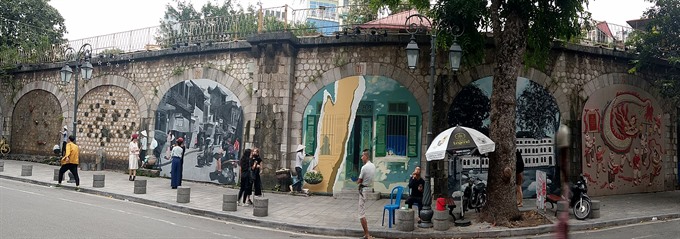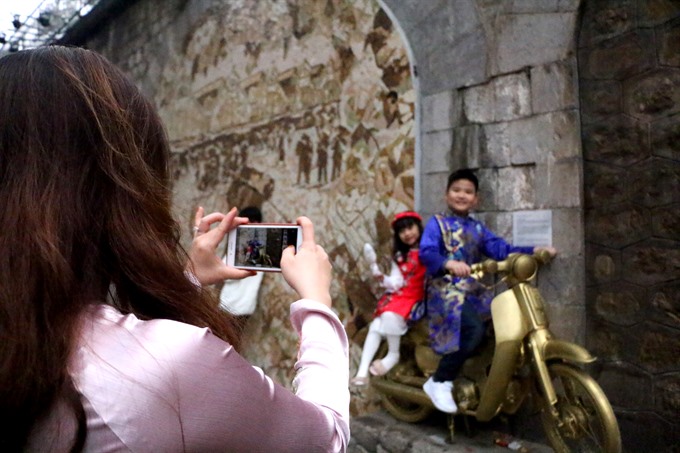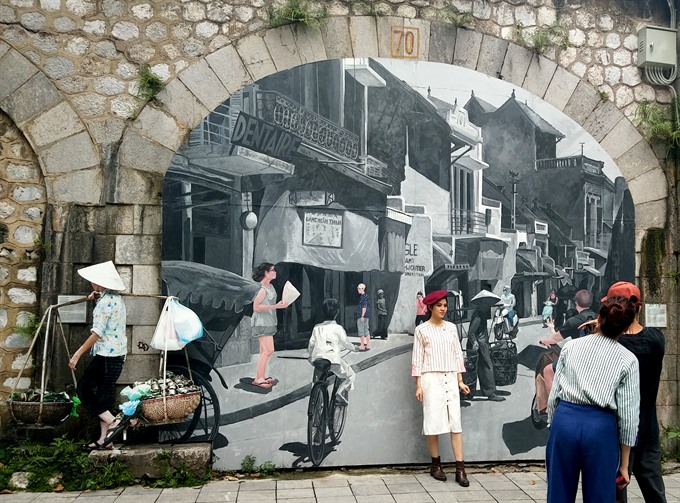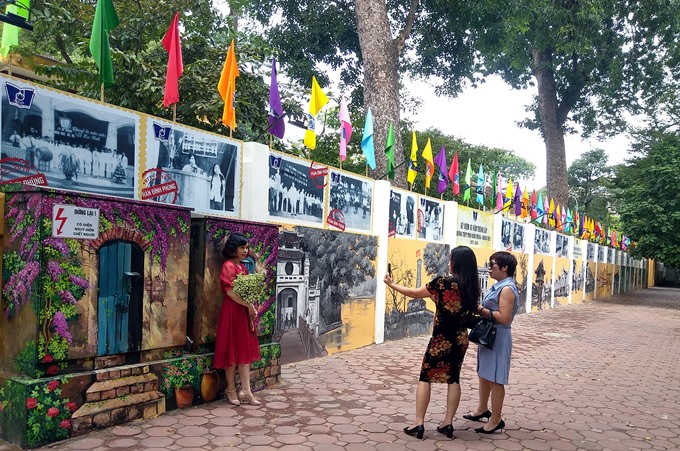 Features
Features

The rising number of murals has breathed new life into Hà Nội’s streets, however, artists and art-lovers warn that poor paintings popping up all over the city are threatening the value of street art as well as the capital’s image.
 |
| Popular spot: Part of the wall on Phùng Hưng Street. VNS Photo Đoàn Tùng |
Đào Mai Phương
The rising number of murals has breathed new life into Hà Nội’s streets, however, artists and art-lovers warn that poor paintings popping up all over the city are threatening the value of street art as well as the capital’s image.
Around 10 years ago, a ’ceramic mosaic mural’ was put up along the Red River dyke in Hà Nội. The impressive stretch of art runs from Trần Khánh Dư Street in Hai Bà Trưng District to Nghi Tàm in Tây Hồ District, marking a milestone for street art in the capital city.
It is not hard today to find hundreds of walls covered with paintings on daily life, historical scenes and landscapes.
Streets with murals include Phùng Hưng, Phan Đình Phùng, Duy Tân, Hồ Tùng Mậu, Chùa Láng and villages such as Phú Thượng and Đan Phượng.
Nevertheless, instead of receiving appreciation like the ceramic work, the movement today has caused concern among Việt Nam’s art community.
Some said many of the wall paintings were not good, while others said the explosion of street art was uncontrolled.
“Most of the murals, particularly on small streets, are obviously created by unqualified artists. They are likely just students or those who do not have experience with painting large frescos,” artist Bùi Hoàng Dương told Việt Nam News.
 |
| Snap happy: Wall paintings on Phùng Hưng Street attract attention from visitors. VNS Photo Đoàn Tùng |
Dương revealed that in many cases, artists who were awarded contracts from city authorities hired students to do the work, resulting in low-quality murals.
“Street art stems from wandering painters who want to show off their talent and attract the attention of passers-by,” Dương said.
Street art is also used as a tool to boost tourism and authorities were keen on using this practice to brighten up the city.
Dương mentioned the ceramic mosaic mural as a good example of Hà Nội’s success in promoting the image of the capital city.
The 810m section of the ceramic mosaic set a Guinness World Record in 2010 for the largest ceramic mosaic with a plaque “in celebration of Thăng Long-Hà Nội’s millennium anniversary”.
It also helped improve public awareness about the city’s history and culture.
However, Dương said since murals have spread, many of the works have lost sight of this aim. They now focus on the creators’ ideas and are not popular among the public.
Some of the viewers themselves had vandalised the works.
As they did not understand the major aims of the art and thought it was a kind of public property, they intentionally ruined them by damaging the walls or adding their own details.
Meanwhile, artist Bùi Thanh Phương said murals should only be used to make streets more beautiful.
“If street art becomes a trend, it is easy for it to be abused and it will become a disaster,” said Phương.
 |
| New designs: Street art is often used as a tool to boost tourism and Hà Nội authorities were keen on using this method to brighten up the city. VNS Photo Đoàn Tùng |
 |
| Perfect pics: In contrast to the quiet and peaceful atmosphere of the past, Phan Đình Phùng Street has become more crowded with visitors using the mural as a backdrop for their selfies. VNS Photo Đoàn Tùng |
The Hà Nội-based artist commented that the abuse of street art will make streets less attractive.
Phan Đình Phùng is often regarded as one of the most peaceful in Hà Nội, which is now witnessing big changes after a fresco went up on one of its walls.
Instead of the quiet and peaceful atmosphere of the past, the street now has become more and more crowded with teenagers using the mural paintings as a backdrop for their selfies.
Hoàng Trọng Bách, a man living near the street, told Việt Nam News he felt the paintings did not convey the ideas of the artists.
“Some of them (the paintings) do not possess any sense of beauty or art," Bách complained.
Meanwhile, Nguyễn Ngọc Tiến, a researcher, said there was no need for the murals on Phan Đình Phùng.
“The street itself was nice before the painting. Its wide pavements and old trees surrounding French-style villas were more beautiful,” Tiến was quoted as saying on laodong.vn.
Artist Trần Khánh Chương appealed for painters to be more considerate before undertaking a street art project.
“Street art should be controlled in Hà Nội because if it becomes rampant, the risk of ‘visual pollution’ will rise," said Chương.
According to the artist, Hà Nội is in need of planning and managing the murals in streets, not to let them free and rampant as it happens now.
The Hà Nội Department of Culture and Sports is responsible for granting permits to large street art projects but not small murals.
Thus the department appealed for more participation from authorities and local people in assessing and managing the content and quality of small-scale paintings. VNS




